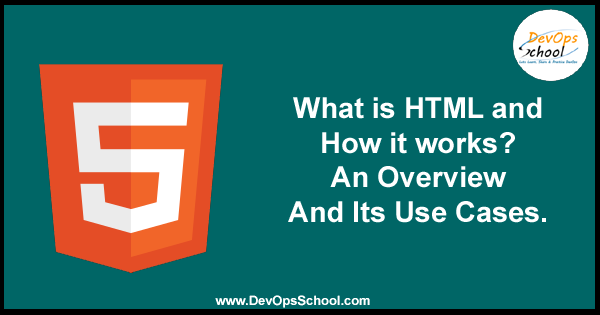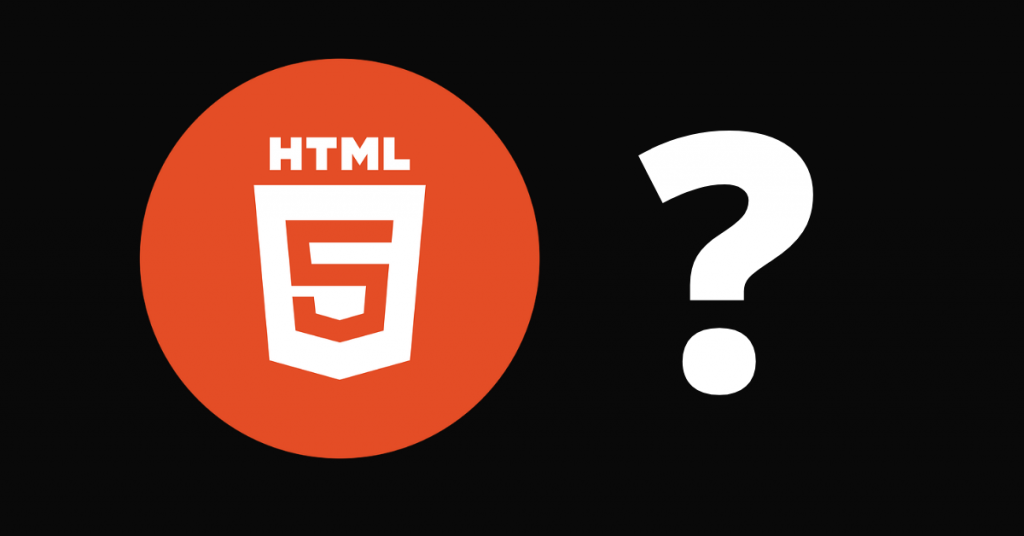

History & Origin of HTML
HTML is a markup language used by the browser to manipulate text, images, and other content, in order to display it in the required format. HTML was created by Tim Berners-Lee in 1991. The first-ever version of HTML was HTML 1.0, but the first standard version was HTML 2.0, published in 1999.
HTML stands for HyperText Markup Language. It is used to design web pages using a markup language. HTML is the combination of Hypertext and Markup language. Hypertext defines the link between the web pages. A markup language is used to define the text document within tag which defines the structure of web pages. This language is used to annotate (make notes for the computer) text so that a machine can understand it and manipulate text accordingly. The language uses tags to define what manipulation has to be done on the text.
What is HTML?

Hypertext Markup Language (HTML) is a programming language that displays data and describes a web page’s structure. Hypertext facilitates browsing the web by referring to the hyperlinks an HTML page contains. The hyperlink enables one to go to any place on the internet by clicking it. There is no set order to do so.
Markup language points out to the way tags are used in defining the page layout and the elements within the page. It consists of various HTML elements comprising tags and their content. HTML language enables the creation of links of documents, is static, and can ignore small errors. In HTML, closing tags are not necessary. It can be defined as a markup language that makes the text more dynamic and interactive.
HTML is a computer language used to create websites that can be viewed by anyone with internet access. The tags are the words between the <angle brackets> and separate standard text from HTML code. These are displayed on web pages in the form of images, tables, diagrams, and so on.
Why Learn HTML?
HTML was developed with the intent of defining the structure of documents like headings, paragraphs, lists, and so forth to facilitate the sharing of scientific information between researchers. Now, HTML is being widely used to format web pages with the help of different tags available in HTML language.
HTML is a MUST for students and working professionals to become great Software Engineers especially when they are working in Web Development Domain. I will list down some of the key advantages of learning HTML:
- Create a Web site – You can create a website or customize an existing web template if you know HTML well.
- Become a web designer – If you want to start a career as a professional web designer, HTML and CSS designing is a must skill.
- Understand web – If you want to optimize your website, to boost its speed and performance, it is good to know HTML to yield the best results.
- Learn other languages – Once you understand the basics of HTML then other related technologies like javascript, PHP, or angular have become easier to understand.
Features of HTML
- It is easy to learn and easy to use.
- It is platform-independent.
- Images, videos, and audio can be added to a web page.
- Hypertext can be added to the text.
- It is a markup language.
Advantages
- HTML is used to build websites.
- It is supported by all browsers.
- It can be integrated with other languages like CSS, JavaScript, etc.
Disadvantages
- HTML can only create static web pages. For dynamic web pages, other languages have to be used.
- A large amount of code has to be written to create a simple web page.
- The security feature is not good.
Best resources to learn HTML
https://www.devopsschool.com/blog/?s=html
Free Video Tutorials HTML
HTML Interview Questions and Answer
1. What is HTML?
HTML is an acronym of HyperText Markup Language. It is a markup language used by WWW (World Wide Web) to create web pages.
2. What is the latest version of HTML?
The latest version of HTML is HTML5, and it was published by W3C recommendation on October 28, 2014.
3.What is HTML 5?
HTML 5 is the latest edition of HTML and the latest language used by WWW.
4. Can I hide my HTML code from the user?
No, the browser needs our code to display the web pages, and the browser allows the users to see the code.
5. Give some new features introduced in HTML5?
- Introduction of new elements and attributes.
- New semantic elements like <header> and <footer>.
- It comes with bi-directional communication for web applications.
- HTML introduces Server-Sent Events (SSE).
- It allows us to add audio and video to the web pages.
7. Why do we write Doctype at the top of each HTML page?
Doctype is a special syntax given to HTML pages. It is a syntax because <!DOCTRYPE> is not a tag. The Doctype statement in HTML tells the browser to open this web page in a standard model, and it acquaints the web page with the latest edition of HTML without specifying the specific versions.
8. What happens if we do not mention <!DOCTRYPE> it on an HTML page?
We would not be able to avail of the latest features of HTML and get stuck with the old ones. If there is no <!DOCTRYPE>, the browser will get no information about the version of the HTML used in that specific web page.
9. What are tags?
Tags are a kind of pre-defined code in HTML. They start with < sign and end with > sign. HTML tags tell the browser what to do. Once we have opened an HTML tag, we have to close it and to close an HTML tag, we use the / symbol. Most of the HTML tags come in pairs. E.g. <h1> </h1>, <p> </p>, etc.
10. Do all HTML tags come in pairs?
No, some tags like <img>, <br>, and so on are not in a pair.
11. Name all the lists we use in HTML.
- Ordered list
- Unordered list
- Definition list
- Menu list
- Directory list
12.Name new media elements in HTML5.
<audio>
<video>
<source>
<embed>
<track>
13. Why do we use the canvas elements in HTML5?
HTML5 has a new element known as canvas, which is used to create charts, graphs, photoshop 2D images, and more.
14. What are comments in HTML, and how to insert one?
Comments are the special statements in HTML that do not execute and are not displayed on the web browser.
We write a comment inside <! > the tag. For example:
<! –comment —–>
15. What is the key difference between HTML elements and tags?
Elements are the predefined code that renders the text in different formats, and when an element is enclosed by brackets <> we call it a tag.
16. Name all the headings in HTML.
HTML has 6 headings, from <h1> to <h6>, and each heading has its own size. The text size descend from <h1> to <h6>.
Heading 1
Heading 2
Heading 3
Heading 4
Heading 5
Heading 6
17. How can we format the HTML text?
HTML provides us tags like <strong>, <en>, and <i> to format the text. Formatting HTML text makes it more legible and provides a rich interface.
18. Mention some new form elements introduced in HTML5.
Web pages use forms to collect data from the user so that appropriate operations can be performed at the back-end. Before HTML5, HTML used different kinds of forms elements like text field, password, drop-down menus, and so on. In HTML5, some new elements are introduced such as <datalist>, <keygen>
and <output>.
19. Name the types of web storage in HTML5.
HTML5 has two types of web storage: Session storage:
- In session storage, data is stored temporarily until the browser is closed. Once we close the browser, the data is lost.
- Local Storage: In local storage, data does not get deleted even when the browser is closed. To delete the data, we have to manually do so in the browser settings.
20. Give two advantages of HTML5 web storage.
It has a storage of 10 MB, which is more than what a cookie can have.
The storage data can be transferred through HTTP requests.
- Mastering Qualitative Research: The Role of Focus Groups in Data Collection - July 11, 2024
- What is robots ops? - July 10, 2024
- 5 Effective Online Learning Strategies for DevOps Professionals - July 4, 2024

